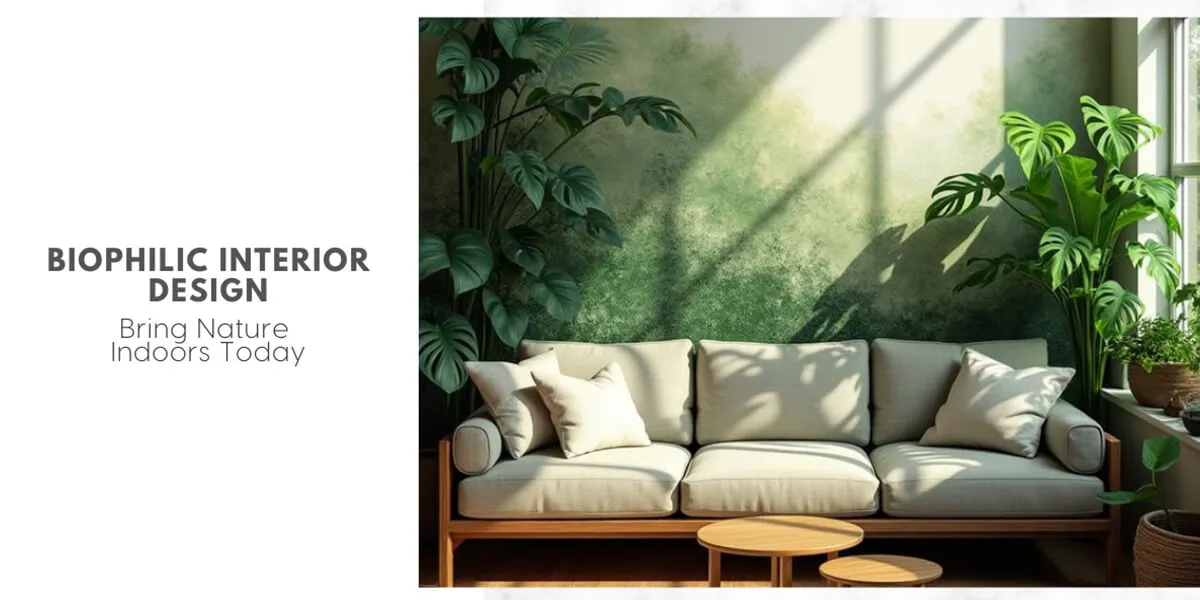Biophilic Interior Design: Bring Nature Indoors Today

Biophilic design is making strides in interior design. It has introduced an energising trend, seamlessly integrating the beauty of nature into two key places:
- Our daily lives.
- Our working spaces.
Biophilic interior design is more than just an aesthetic option. It aims to make a closer bond between the human environment and the natural world. The philosophy of this design goes beyond typical decoration. It taps into the natural affinity of humans for nature.
What does it do? It harnesses the power of nature to enhance human productivity and well-being. The design also helps transform spaces into environments that support human health and provide a calm refuge.
How good are the elements of biophilic interior design?
Biophilic design elements stand out for their ability to bring life to spaces. They emphasise sustainability and a deep-rooted connection to the natural environment. We can explore how essential and impactful connections with nature can enhance our indoor spaces through biophilic design.
Biophilic design and the natural environment – what to understand?
Biophilic design is colloquially known as eco friendly home interior design. Scientific research has demonstrated that exposure to natural materials and textures can help reduce stress and improve overall well-being in humans. The presence of custom moss wall art in human surroundings can reduce stress by a considerable percentage.
In its fundamental sense, naturalistic interior design does its best to integrate the following into internal surroundings:
- Natural light of the sun.
- Organic materials.
- Plant life (Flora and Fauna).
This helps mimic the natural outdoor environment. This allows designers to create nature inspired interior design to help improve the quality of human life. Interior designers create modern interiors. They embrace the following in reducing the gap between the inside and outside:
- Greenery.
- Water Features.
- Natural Textures.
- Sustainable Wooden Furniture.
- Earthy Colour Palettes.
Understanding the Core Elements of Biophilic Interior Design
Top-notch biophilic design is the by-product of numerous core elements. We will discuss the key ones in the following points:
Embracing Natural Air and Light
Maximising the use of natural light is key. It helps create a connection to the natural surroundings outside. The following helps bring natural daylight to spaces and also ensures proper air flow and ventilation:
- Large Windows.
- Open Floor Plans.
- Skylights.
The infusion of natural light helps create a dynamic ambience, energising both the inner space and its occupants.
Usage of Organic Materials
Incorporating natural and organic materials, such as natural fibres, stone, and wood, is a key principle of biophilic design. These materials help add the following to inner spaces:
- A sense of originality.
- Organic and pleasing textures.
- Warmth.
Custom moss wall art is a striking example of organic elements merging art with nature. This offers a unique and essential point that raises the spirits of any room.
Usage of Greenery and Living Walls
Both indoor plants and green walls are essential components of biophilic design. They help in:
- Improving the air quality of inner spaces.
- Amplifying the visual aesthetics.
- Making a comforting atmosphere.
Regardless of whether it is a vertical garden or potted plants arranged in sequence, the presence of living greenery helps enhance the innate connection between humans and the natural world.
Patterns and Textures Inspired by Mother Nature
Mother Nature is always inspirational. It has provided interior designers with numerous inspirations, whether it is the subtle veining in a marble countertop or the intricate patterns of a leaf.
Incorporating these patterns and textures in design elements, custom installations, or furniture helps make a sensory-enriched environment. This helps provide delight and relaxation to inhabitants.
Connected with Nature across Multiple Dimensions
Creating multidimensional and visual connections to nature is essential. It may include the following:
- Designing spaces with a good view of the outdoors.
- Incorporating Indoor Water Features.
- Use of reflective surfaces mimicking the natural landscape.
The objective is to create an immersive experience that blurs the boundaries between indoor and outdoor spaces.
The unmatchable benefits of Biophilic Design
The benefits of biophilic design are undeniable and proven scientifically. Let us now discuss them in brief detail:
Improvement in the mental well-being of inhabitants
Nature has always been associated with calmness and tranquillity. Biophilic Interior Design leverages these benefits by creating spaces that help reduce anxiety and stress. Scientific studies have proven that the presence of natural elements indoors helps reduce cortisol levels. They contribute to a naturally healthy indoor environment.
Naturally improving the indoor air quality
Indoor plants serve as air purifiers. The following species can help eliminate toxins from the air and promote a cleaner and fresher atmosphere than ever:
- Ferns.
- Peace Lillies.
- Snake Plants.
This is particularly important in urban areas, where air pollution levels are concerning.
It boosts productivity
Workspaces designed with biophilic interior elements can enhance creativity, focus, and overall productivity in humans. Greenery, natural light, and open spaces help improve cognitive function. Both home offices and creative workspaces utilise biophilic design to differentiate themselves.
Over to You
Biophilic Interior Design is indeed a lifesaver. It helps offices improve their existing infrastructure by incorporating natural environmental elements, which can help reduce congestion and constraints in office spaces. This helps protect the environment and make inner spaces inhabitable.

